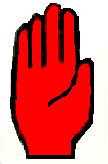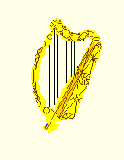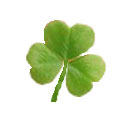Image |
Details
|
 |
Title: Red Hand of Ulster
Description: The Red Hand of Ulster is the official seal of the O'Neill family. It is believed to originate from a mythical tale wherein two chieftains were racing across a stretch of water in a bid to be the first to reach the land and claim it as his own. Realising his foe would touch the land first, one chieftain cut off his hand and threw it onto the shore, thereby claiming the land before his adversary reached it. The Red Hand is one of the only emblems in Northern Ireland used by both communities in Northern Ireland although it is more associated with the Protestant community. Catholics see it as representing the nine counties of Ulster while Protestants see it as representing the six counties of Northern Ireland. The Red Hand of Ulster appears on many murals and flags.
|
 |
Title: Harp
Description: This ancient instrument has long symbolised the island of Ireland. It's Nationalist origins come from when Owen Roe O'Neill, a Gaelic Chieftain, adopted a green flag incorporating the harp. Being seen as a threat to the English invaders, playing the harp was banned, despite remaining on the royal insignia as representing Ireland in the growing British Empire. It was revived in Belfast in 1792, and was the prime symbol of the United Irishmen. The symbol of the harp also represents Loyalist Irishmen when it is surmounted by a crown and it is used in this form on, for example, the cap badges of the Royal Ulster Constabulary.
|
 |
Title: Shamrock
Description: Legend has it that the shamrock was used by St. Patrick, the patron saint of Ireland, to illustrate the Holy Trinity, hence its widespread use on St. Patrick's day on 17 March. It is one of Ireland's national emblems, and is used by mainly by the Nationalist tradition, but is also evident within the Unionist tradition, with bodies such as the Royal Irish Rangers wearing the Shamrock every St. Patrick's day.
|
 |
Title: White Ribbon
Description: A number of symbols of peace have been used over the past thirty years by various organisations. Most recently those campaigning for peace have worn a white ribbon in their lapels. In the past white paper doves have been held aloft at peace demonstrations.
|
 |
Title: Cú Chulainn
Description: Also known as the 'Hound of Ulster', or Setanta, this Celtic mythical figure can be found on both Republican and (more recently) Loyalist murals. Opposite he is shown dying against a pillar after he fought Queen Maeve's armies of Connaught, who were only sure he was dead after a raven landed on his shoulder. He embodies resilience against invaders, thus proving to be an apt figure for both Protestant and Catholic communities. This statue can be found in Dublin's General Post Office.
|





